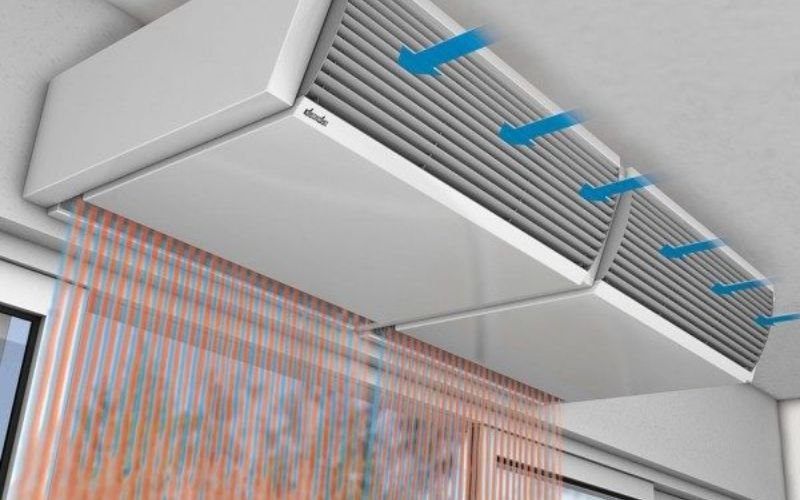How Air Curtains Improve Energy Efficiency in Commercial Spaces
Air curtains are invisible barriers that separate two environments in a store, keeping cool air in and hot air out. They not only put consumers at ease but also enable companies to save money and energy. This blog talks about why air curtains are useful in businesses and how they can help make buildings more energy-efficient.
How Do Air Curtains Work?
Air curtains work on a simple principle: air in motion stays in motion. An air curtain generates a continuous stream when blown downward. This stream creates a barrier.
The air from the curtain moves fast. It’s faster than the air trying to move in or out of the building. This speed difference is key. It’s what allows the air curtain to block air movement between inside and outside.
With curtain services in Dubai , air curtains can be adjusted for different needs. In summer, they might blow cooler air to keep heat out. In winter, they might use warmer air to block cold drafts. Some advanced air curtains even adjust automatically based on the weather.
The efficiency of an air curtain depends on various elements. These include the air’s speed, the angle of the air stream, and the installation’s height. Correct setup not only ensures the effectiveness of air curtains in isolating indoor from outdoor spaces but also minimizes the need for frequent maintenance, complementing professional curtain cleaning services to keep your interiors fresh and clean.
Benefits of Air Curtains in Commercial Spaces
Businesses can gain much from air curtains. Let’s review some of the primary benefits now:
- Improved Comfort: Air curtains create a more stable indoor environment. This means customers and employees stay comfortable, even when doors are open.
- Insect Control: Air curtains can help to keep flying insects out. For food businesses and restaurants particularly, this is crucial.
- Dust and Pollution Reduction: The air barrier can block dust, pollen, and other pollutants. This helps maintain better air quality inside.
- Noise Reduction: Air curtains can assist in lowering outside noise levels. This produces a more comfortable, quieter inside space.
- Increased Visibility: Unlike physical doors, air curtains don’t block the view. This can make stores more inviting to customers.
Many different kinds of companies find air curtains appealing for these advantages. Retail businesses, restaurants, hotels, and even certain factories have them somewhat often.
How Air Curtains Improve Energy Efficiency
By restricting the airflow between inside and outside, air curtains lower heat transfer. Less hot air entering during the summer and less cold air entering during the winter lets heating and cooling systems run more effectively. Air curtains lower the energy required to change the temperature by keeping a constant indoor atmosphere and lowering temperature variations.
Many times, businesses keep their doors open to draw business, which results in large energy waste. Air curtains let companies leave their doors open without losing conditioned air. Further lowering energy use is the way air curtains enable areas to restore to the intended temperature more rapidly when doors close.
Studies showing up to an 80% decrease in energy loss around doorways indicate that air curtains can save significant amounts of energy. For companies with lots of foot activity, this can result in big energy bill savings.
Types of Air Curtains
Air curtains come in various types. The right choice depends on the specific needs of a space. Here are some common types:
- Recirculating Air Curtains: They build the air barrier using indoor air. Since they don’t create fresh air that has to be heated or cooled, they are energy-efficient.
- Heated Air Curtains: These blow warm air, making them ideal for cold climates. They can supplement a building’s heating system.
- Ambient Air Curtains:These use air at room temperature, ideal for summer or mild climates, and pair well with sheer curtains for added light.
- Industrial Air Curtains: Large openings like loading docks call for heavy-duty industrial air curtains.
Each type has its strengths. The best choice depends on factors like climate, door size, and building use.
Real-World Examples and Case Studies
Let’s look at some real examples of air curtains in action:
Retail Store Chain:
A major clothing retailer installed air curtains in 100 stores. The curtains Repair paid for themselves with 30% energy efficiency in less than two years.
Restaurant:
A busy café installed an air curtain over its main entrance. They noticed a reduction in their heating and cooling costs by 25%. They also noticed fewer complaints about drafts from customers.
Warehouse:
A large distribution center put air curtains on its loading docks. This reduced their energy use for heating by 40% in winter. It also improved working conditions for employees.
These examples show the real impact air curtains can have. They’re not just theory – they deliver measurable benefits in various settings.
The Future of Air Curtain Technology
Air curtain technology continues to advance. Here are some trends to watch:
- Smart Controls: New air curtains can adjust automatically based on outdoor conditions. They can even learn patterns of use over time.
- Energy Recovery: Some systems can capture and reuse the energy in the air they move. This further increases efficiency.
- Improved Design: Manufacturers are making air curtains more compact and aesthetically pleasing. This makes them suitable for more locations.
- Integration with Building Management Systems: Air curtains are becoming part of overall building control systems. This allows for better coordination with other energy-saving measures.
Air curtains will probably get even more efficient and extensively applied as technology develops.
Conclusion: A Smart Choice for Energy Efficiency
Create an invisible barrier with air curtains to make commercial areas more energy efficient. Apart from saving energy, they also help to have comfortable surroundings and cut expenses. Technological developments are driving air curtains’ increasing efficiency and adaptability. Rising energy prices are vital for sustainable and efficient structures, so they are a good investment in comfort and economy.


